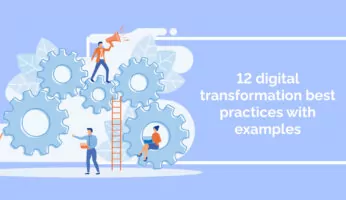
What is business change, really? In this post, we’ll look at a business change def, today’s trends, and how business will change in the future.
Business Change Def – What Does Business Change Really Mean?
What does business change really mean?
Is it a change to processes, people, tools, or something else?
There is actually more than one answer, because there is more than one type of organizational change.
Changes can impact:
- People. Most business changes affect people to some extent. A new remote working policy, for instance, would certainly affect the workforce. As would a new software application, new rules, a new dress code, or a new office design. Some, though, are aimed at people. Changing the organizational culture is one example. This type of change would target areas such as behaviors, rules, communication styles, and more.
- Processes. Processes are another common target of business change projects. Process changes can affect workflows, day-to-day job tasks, and more. These process changes usually support other business actions, such as strategy changes or performance improvements.
- Systems and tools. Systems, such as IT systems, are also a target of business change. These types of changes are common today, thanks to widespread digital innovation. Every year, for instance, new technology is released that changes the way we do business, create products, and deliver services.
- Business strategy. Another type of business change focuses on business strategy. A strategy change affects the direction of the business – for instance, a company selling one type of product may add another type of product to its product line. Or a company focusing on offline marketing may change to online marketing.
- Business structure. Restructuring is common during big business changes. Examples include: layoffs, changing team members in a department, building new departments, combining several teams into one, and adding a new company division.
Business change projects may focus on one of these areas, such as a structure change.
But it is important to remember that a change in one area will affect changes in another.
A company that adds a new product line, for example, will likely also make other changes, such as hiring new teams, restructuring departments, and so forth.
Business Change Trends
Today, businesses are changing faster than ever.
In the digital age, companies are changing strategies, adopting new technology, innovating, and investing in change more than ever – but why?
There are a few trends pushing these changes forward, including:
- Disruptive innovation. Technology is easily the biggest cause of change in today’s world. New technology adoption, such as the adoption of internet and mobile phones, created huge changes in every area of society. Those changes, in turn, have created major organizational changes. In some cases, entirely new industries have grown out of new technologies. Mobile app developers, for example, make their living off of mobile technology – a technology that didn’t exist a few years ago.
- Time. Time itself is another driver of business change. Time can change customer demands, geopolitics, the marketplace, a company’s competitive position, and more.
- Crises. Crises have negative effects on the economy, in general. The financial crisis of 2008, for example, harmed the job market and reduced spending for many people. Yet crises also drive change. In 2020, for instance, COVID-19 actually accelerated business change in several ways. Companies around the world, for example, adopted remote working policies, became more digital, and became more agile.
- Customers. Customer needs also fuel business change. When customers demand a new product, such as a mobile app, companies follow the money and create that product. When customers’ spending habits change, businesses must change their strategies.
These are a few examples of the big trends that cause change in business.
Today, these types of trends are speeding up business change, and in the years ahead, we can expect to see an even faster rate of change.
Will Businesses Change More in the 2020s?
One of the biggest drivers of change in today’s market is technology, as noted above.
Since technology is still evolving, we’ll see even more technology-driven change in the years ahead.
Throughout the 2020s, expect to see changes such as:
- More technology. Automation, AI, robots, VR, blockchain, and other emerging technologies promise to revolutionize the globe. And as they change the way we live and communicate, businesses will also change. As a result, digital transformation will likely become the norm for years.
- A focus on agility. Agile businesses focus on adapting to change, rather than sticking to existing processes. To keep up with disruption, this focus will become essential, especially as more emerging technologies become mainstream.
- More change. The future holds more disruption, more innovation, and more change. For businesses, this means rethinking strategies and business models. For employees, training and upskilling are the best way to stay relevant and marketable.
In short, the 2020s will be a decade of great change – and those changes will accelerate into 2030 and beyond.
WalkMe Team
WalkMe spearheaded the Digital Adoption Platform (DAP) for associations to use the maximum capacity of their advanced resources. Utilizing man-made consciousness, AI, and context-oriented direction, WalkMe adds a powerful UI layer to raise the computerized proficiency, everything being equal.



